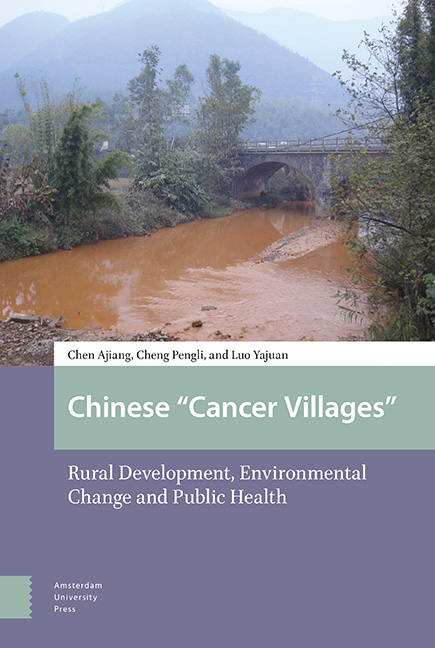Book contents
- Frontmatter
- Contents
- List of Figures, Graphs and Tables
- Acknowledgements
- Preface to the English Language Edition
- 1 Retrospective Thoughts on the ‘Cancer Village’ Phenomenon
- 2 The Ins and Outs of a ‘Cancer Village’
- 3 A Subei ‘Cancer Village’
- 4 Environmental Change and Health Risks
- 5 A Prosperous ‘Cancer Village’
- 6 Coexistence of Poverty and Cancer
- 7 Problematization and De-stigmatization
- 8 Behind the ‘High Incidence of Lung Cancer’
- 9 Villagers’ Perceptions of and Responses to the Relationship between Cancer and Pollution
- 10 Villagers Strategies for Mitigating Environmental Health Risks
- Index
- Index (Chinese) 中文索引
7 - Problematization and De-stigmatization
Published online by Cambridge University Press: 20 November 2020
- Frontmatter
- Contents
- List of Figures, Graphs and Tables
- Acknowledgements
- Preface to the English Language Edition
- 1 Retrospective Thoughts on the ‘Cancer Village’ Phenomenon
- 2 The Ins and Outs of a ‘Cancer Village’
- 3 A Subei ‘Cancer Village’
- 4 Environmental Change and Health Risks
- 5 A Prosperous ‘Cancer Village’
- 6 Coexistence of Poverty and Cancer
- 7 Problematization and De-stigmatization
- 8 Behind the ‘High Incidence of Lung Cancer’
- 9 Villagers’ Perceptions of and Responses to the Relationship between Cancer and Pollution
- 10 Villagers Strategies for Mitigating Environmental Health Risks
- Index
- Index (Chinese) 中文索引
Summary
Abstract
Although they live up and downstream on the same polluted river, residents of the two villages of Liangqiao and Shangba have quite different perceptions of the risk of heavy metal pollution from a local mine and different responses to it. At the time of this research, Liangqiao villagers were actively trying to problematize pollution, and attract attention in order to resolve it, while Shangba had already gone through this process of problematization, and realized that although it had brought some relief, being known as a ‘cancer village’ also had downsides. It was now trying to ‘de-stigmatize’ the community. The differences between the two communities were largely related to factors such as clan organization, local or migrant origin, population size, economic power and other such factors.
Keywords: heavy metal pollution, media, village elites, village scale, comparative research
Introduction
The villages in this case study are situated in the mountains of northern Guangdong province where some large mining enterprises are located. Mine tailings and waste water flow down the course of the river, and over many years they polluted the villages mid and downstream. The farmland around the villages suffered heavy metal pollution, which damaged villagers’ health and also led to secondary social problems.
The Mine
B mine is located in a county in northern Guangdong Province. The county is surrounded by mountains which rise in waves from the northeast to the southwest and cover around 80% of the county. Due to the hilly and uneven terrain, there is not much room for paddy fields. The main food crop is rice and the main cash crop is sugar cane. The topography of the county is diverse, the geological structure is complex, and the area is rich in mineral resources.
B mine exploits the large deposits of multiple metals in the area. The main minerals are iron ores but there is also copper, tungsten, antimony, molybdenum, gold, silver, and other non-ferrous metals. Founded in 1958, B mine is a provincial state-owned mining company. It has always used opencast mining, and over time the tailings and waste water flowed down along the river, polluting the water sources and soil of the villages along its banks with heavy metals.
- Type
- Chapter
- Information
- 'Chinese Cancer Villages'Rural Development, Environmental Change and Public Health, pp. 209 - 228Publisher: Amsterdam University PressPrint publication year: 2020



